Advertisements
Online Mock Tests
Chapters
2: Nutrition in Animals
3: Fibre to Fabric
4: Heat
5: Acids, Bases and Salts
6: Physical and Chemical Changes
7: Weather, Climate and Adaptation of Animals to Climate
8: Wind, Storm and Cyclone
9: Soil
10: Respiration in Organisms
11: Transportation in Animals and Plants
12: Reproduction in Plants
▶ 13: Motion and Time
14: Electric Current and Its Effects
15: Light
16: Water : A Precious Resource
17: Forests : Our Lifeline
18: Wastewater Story
![NCERT Exemplar solutions for Science [English] Class 7 chapter 13 - Motion and Time NCERT Exemplar solutions for Science [English] Class 7 chapter 13 - Motion and Time - Shaalaa.com](/images/science-english-class-7_6:5f2b1b2038084cf381bfa42c826a928c.jpg)
Advertisements
Solutions for Chapter 13: Motion and Time
Below listed, you can find solutions for Chapter 13 of CBSE NCERT Exemplar for Science [English] Class 7.
NCERT Exemplar solutions for Science [English] Class 7 13 Motion and Time MULTIPLE CHOICE QUESTIONS [Pages 67 - 70]
Which of the following cannot be used for the measurement of time?
A leaking tap.
Simple pendulum
Shadow of an object during the day.
Blinking of eyes.
Two clocks A and B are shown in Figure 13.1. Clock A has an hour and a minute hand, whereas clock B has an hour hand, a minute hand as well as a second hand. Which of the following statement is correct for these clocks?

A time interval of 30 seconds can be measured by clock A.
A time interval of 30 seconds cannot be measured by clock B.
A Time interval of 5 minutes can be measured by both A and B.
The Time interval of 4 minutes 10 seconds can be measured by clock A.
Two students were asked to plot a distance-time graph for the motion described in Table A and Table B.
Table A
| Distance moved (m) | 0 | 10 | 20 | 30 | 40 | 50 |
| Time (minutes) | 0 | 2 | 4 | 6 | 8 | 10 |
Table B
| Distance moved (m) | 0 | 5 | 10 | 15 | 20 | 25 |
| Time (minutes) | 0 | 1 | 2 | 3 | 4 | 5 |

The graph given in Figure 13.2 is true for
both A and B.
A only
B only
neither A nor B
A bus travels 54 km in 90 minutes. The speed of the bus is
0.6 m/s
10 m/s
5.4 m/s
3.6 m/s
If we denote speed by S, the distance by D and time by T, the relationship between these quantities is
S = D × T
T = `"S"/"D"`
S = `1/"T" xx "D"`
S = `"T"/"D"`
Observe Figure 13.3.
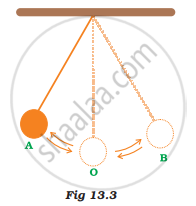
The time period of a simple pendulum is the time taken by it to travel from
A to B and back to A
O to A, A to B and B to A.
B to A, A to B and B to O.
A to B.
Fig. 13.4 shows an oscillating pendulum.
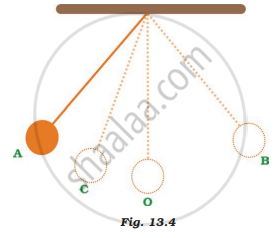
Time taken by the bob to move from A to C is t1 and from C to O is t2. The time period of this simple pendulum is
(t1 + t2)
2(t1 + t 2)
3(t1 + t 2)
4(t1 + t 2)
The correct symbol to represent the speed of an object is
5m/s
5mp
5 m/s−1
5s/m
Boojho walks to his school which is at a distance of 3 km from his home in 30 minutes. On reaching he finds that the school is closed and comes back by bicycle with his friend and reaches home in 20 minutes. His average speed in km/h is
8.3
7.2
5
3.6
NCERT Exemplar solutions for Science [English] Class 7 13 Motion and Time VERY SHORT ANSWER QUESTIONS [Pages 70 - 71]
A simple pendulum is oscillating between two points A and B as shown in Figure 13.5. Is the motion of the bob uniform or non-uniform?
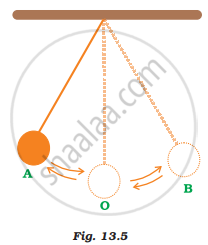
Paheli and Boojho have to cover different distances to reach their school but they take the same time to reach the school. What can you say about their speed?
If Boojho covers a certain distance in one hour and Paheli covers the same distance in two hours, who travels at a higher speed?
NCERT Exemplar solutions for Science [English] Class 7 13 Motion and Time SHORT ANSWER QUESTIONS [Pages 71 - 73]
Complete the data of the table given below with the help of the distance-time graph given in Figure 13.6
| Distance (m) | 0 | 4 | ? | 12 | ? | 20 |
| Time (s) | 0 | 2 | 4 | ? | 8 | 10 |

The average age of children in Class VII is 12 years and 3 months. Express this age in seconds.
A spaceship travels 36,000 km in one hour. Express its speed in km/s.
Starting from A, Paheli moves along a rectangular path ABCD as shown in Figure 13.7. She takes 2 minutes to travel each side. Plot a distance-time graph and explain whether the motion is uniform or non-uniform.
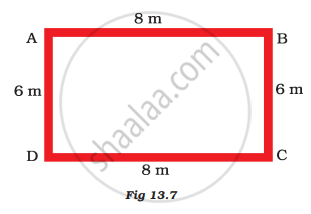
Plot a distance-time graph of the tip of the second hand of a clock by selecting 4 points on the x-axis and y-axis respectively. The circumference of the circle traced by the second hand is 64 cm.
NCERT Exemplar solutions for Science [English] Class 7 13 Motion and Time LONG ANSWER QUESTIONS [Pages 73 - 74]
Given below as Figure 13.8 is the distance-time graph of the motion of an object.
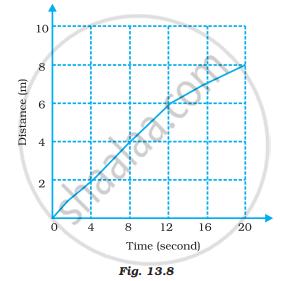
- What will be the position of the object in the 20s?
- What will be the distance travelled by the object in 12s?
- What is the average speed of the object?
The distance between Bholu’s and Golu’s house is 9 km. Bholu has to attend Golu’s birthday party at 7 o’clock. He started from his home at 6 o’clock on his bicycle and covered a distance of 6 km in 40 minutes. At that point, he met Chintu and spoke to him for 5 minutes and reached Golu’s birthday party at 7 o’clock. With what speed did he cover the second part of the journey? Calculate his average speed for the entire journey.
Boojho goes to the football ground to play football. The distance-time graph of his journey from his home to the ground is given in Figure 13.9.
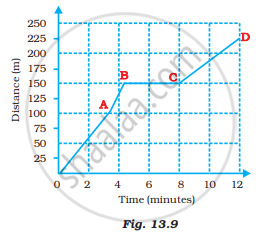
(a) What does the graph between points B and C indicate about the motion of Boojho?
(b) Is the motion between 0 to 4 minutes uniform or nonuniform?
(c) What is his speed between 8 and 12 minutes of his journey?
Solutions for 13: Motion and Time
![NCERT Exemplar solutions for Science [English] Class 7 chapter 13 - Motion and Time NCERT Exemplar solutions for Science [English] Class 7 chapter 13 - Motion and Time - Shaalaa.com](/images/science-english-class-7_6:5f2b1b2038084cf381bfa42c826a928c.jpg)
NCERT Exemplar solutions for Science [English] Class 7 chapter 13 - Motion and Time
Shaalaa.com has the CBSE Mathematics Science [English] Class 7 CBSE solutions in a manner that help students grasp basic concepts better and faster. The detailed, step-by-step solutions will help you understand the concepts better and clarify any confusion. NCERT Exemplar solutions for Mathematics Science [English] Class 7 CBSE 13 (Motion and Time) include all questions with answers and detailed explanations. This will clear students' doubts about questions and improve their application skills while preparing for board exams.
Further, we at Shaalaa.com provide such solutions so students can prepare for written exams. NCERT Exemplar textbook solutions can be a core help for self-study and provide excellent self-help guidance for students.
Concepts covered in Science [English] Class 7 chapter 13 Motion and Time are Measurement of Time, Devices for Measuring Time, Simple Pendulum for Time, Speed, Types of Speed, A Time Period of Oscillation and Frequency, Measuring Speed, Displacement - Time Graph Or Distance - Time Graph, Motion and Rest, Types of Motion.
Using NCERT Exemplar Science [English] Class 7 solutions Motion and Time exercise by students is an easy way to prepare for the exams, as they involve solutions arranged chapter-wise and also page-wise. The questions involved in NCERT Exemplar Solutions are essential questions that can be asked in the final exam. Maximum CBSE Science [English] Class 7 students prefer NCERT Exemplar Textbook Solutions to score more in exams.
Get the free view of Chapter 13, Motion and Time Science [English] Class 7 additional questions for Mathematics Science [English] Class 7 CBSE, and you can use Shaalaa.com to keep it handy for your exam preparation.
